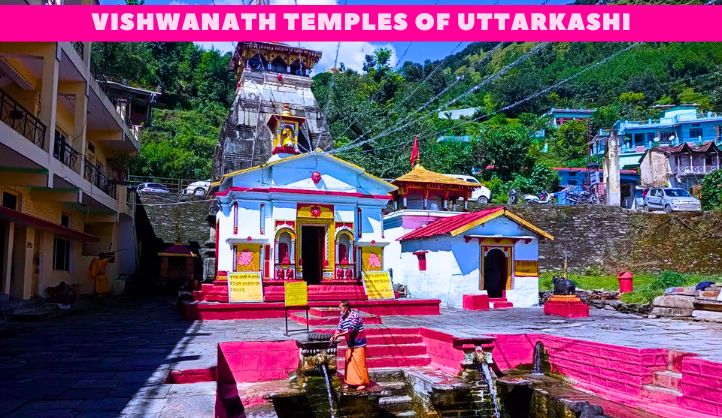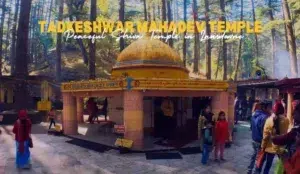Nestled in the majestic Himalayas, the state of Uttarakhand is not just a haven for nature lovers, but also a spiritual center boasting ancient temples that resonate with history and devotion. Among these, the Vishwanath Temples hold a special place, dedicated to Lord Shiva, the embodiment of transformation and dissolution. This article delves into the legend, history, and significance of these two prominent Vishwanath Temples in Uttarakhand – the one in Uttarkashi and the other in Guptkashi.
Uttarkashi’s Vishwanath: A Beacon of Hope for Kali Yuga
The Vishwanath Temple in Uttarkashi, often referred to as Kashi Vishwanath Temple, is an embodiment of faith and legend. Situated on the banks of the holy Bhagirathi River, the temple offers a captivating panorama of the surrounding mountains.
Believed to be one of the oldest and most sacred temples in Uttarkashi, it finds mention in the Skanda Purana, a revered Hindu scripture. The scripture prophesies that during the Kali Yuga (the current age of darkness), when Kashi (Varanasi) faces devastation, Lord Shiva will shift his abode to Uttarkashi. This belief imbues the temple with an otherworldly significance, attracting pilgrims seeking blessings and spiritual solace.
The temple’s history is shrouded in a fascinating narrative. Legends claim that the temple was built by sage Parashuram, a legendary warrior-sage. Another tale attributes its construction to King Ganeshwar, with his son Guh erecting the massive brass trident that stands as a prominent landmark outside the temple. Renovated in 1857 by Maharani Khaneti, the temple showcases the architectural style of the Katyuri dynasty, characterized by the use of stone and a sloping roof that complements the mountainous landscape.
Stepping inside the temple complex, visitors are greeted by a sense of serenity. The sanctum sanctorum houses the revered Shiva Linga, the embodiment of Lord Shiva. Devotees throng the temple throughout the year, particularly during auspicious occasions like Shravan and Shivratri. Witnessing the evening aarti (prayer ceremony) with its enchanting chants and clanging of bells is a truly mesmerizing experience. Adjacent to the main temple lies the Shakti Temple, dedicated to the divine feminine energy. Together, they represent the harmonious union of Shiva and Shakti, the cosmic dance of creation and destruction.
Guptkashi’s Vishwanath: A Serene Abode in the Kedarnath Valley
Further north in the Rudraprayag district lies Guptkashi, another prominent pilgrimage town. Here, nestled amidst towering peaks, stands the Vishwanath Temple, considered one of the Panch Kedars (five Kedarnaths). This temple holds immense significance for pilgrims undertaking the arduous Char Dham Yatra, a holy pilgrimage circuit in the Himalayas.
The Vishwanath Temple in Guptkashi boasts a distinct architectural style reminiscent of other temples in the region, like Kedarnath. Built with sturdy stone, the temple features a high tower over the sanctum and a slanting roof that can withstand the harsh Himalayan climate. Legend associates the temple with the divine union of Lord Shiva and Parvati. It is believed that Lord Shiva proposed to Parvati here, making it a sacred site for couples seeking blessings for their relationship.
The temple complex houses smaller shrines dedicated to various deities, including Ganesha and Hanuman. The tranquil atmosphere and breathtaking vistas of the surrounding mountains create a perfect setting for spiritual reflection. During festivals like Maha Shivratri, the temple comes alive with vibrant celebrations, drawing devotees from all corners of the country.
Beyond the Brick and Mortar: The Allure of the Vishwanath Temples
The Vishwanath Temples of Uttarakhand hold a deep significance beyond their architectural beauty and historical tales. They are testaments to the enduring faith in Lord Shiva and the enduring traditions of Hindu pilgrimage. A visit to these temples is not just a religious experience but also a journey into the vibrant cultural tapestry of Uttarakhand.
Here are some additional aspects that contribute to the allure of these temples:
- Spiritual Significance: The temples offer a chance to connect with the divine and seek blessings for spiritual growth and well-being.
- Cultural Immersion: Visiting the temples allows visitors to witness traditional Hindu rituals, prayers, and festivals, providing a glimpse into the rich cultural heritage of the region.
- Scenic Beauty: Nestled amidst breathtaking landscapes, the temples offer a chance to combine spiritual exploration with a connection to nature.
- Peace and Tranquility: The serene atmosphere of the temples provides a refuge from the hustle and bustle of everyday life, fostering a sense of inner peace.
Planning Your Visit to the Vishwanath Temples
If you’re planning a pilgrimage or simply seeking a spiritual escape, the Vishwanath Temples in Uttarakhand offer a rewarding experience. Here’s some information to help you plan your visit:
Uttarkashi’s Vishwanath Temple:
- Location: Situated on the banks of the Bhagirathi River in Uttarkashi town. Easily accessible by road from major cities like Rishikesh and Dehradun.
- Best Time to Visit: The temple is open year-round, but the ideal time to visit is during the spring (March-May) and autumn (September-November) months when the weather is pleasant.
- Accommodation: Uttarkashi offers a variety of accommodation options, from budget guesthouses to comfortable hotels.
- Activities: Combine your visit with a pilgrimage to Gangotri and other holy sites nearby. Explore the scenic beauty of the Himalayas through nature walks or adventure activities like trekking and rafting.
Guptkashi’s Vishwanath Temple:
- Location: Nestled in the Rudraprayag district, Guptkashi is a stop on the Char Dham Yatra route.
- Best Time to Visit: April to June and September to November offer pleasant weather for visiting. However, if you’re part of the Char Dham Yatra, the temple is accessible only during the summer months when the high mountain passes are open.
- Accommodation: Guptkashi offers basic to mid-range accommodation options.
- Activities: Explore the other Panch Kedars (Kedarnath, Tungnath, Rudranath, and Madhyamaheshwar) if time permits. Enjoy scenic hikes and witness the captivating beauty of the Himalayas.
General Tips:
- Dress modestly: As with most Hindu temples, respectful attire is recommended. Opt for covered shoulders and knees for both men and women.
- Photography: Photography is usually allowed within the temple complex, but it’s advisable to seek permission from the temple authorities before clicking pictures.
- Offerings: Devotees often offer flowers, fruits, and sweets to the deities. You can purchase these from vendors near the temple entrance.
- Respectful behavior: Maintain silence and observe the ongoing prayers and rituals with respect.
Conclusion
Visiting the Vishwanath Temples of Uttarakhand is an enriching experience that transcends religious affiliation. It’s a journey that allows you to delve into the heart of Hindu traditions, appreciate the beauty of the Himalayas, and discover a sense of peace within yourself. So, pack your bags, embrace the spirit of exploration, and embark on a pilgrimage to these sacred abodes of Lord Shiva.
FAQs About Vishwanath Temples in Uttarakhand
Q: Where are the two main Vishwanath Temples in Uttarakhand?
A: Uttarkashi and Guptkashi. Uttarkashi’s temple is sometimes called Kashi Vishwanath Temple.
Q: Why are these temples important?
A: Both are dedicated to Lord Shiva, a key Hindu deity. Uttarkashi’s temple holds a special belief – it might become Shiva’s future abode. Guptkashi’s temple is significant for couples seeking blessings.
Q: When is the best time to visit?
A: Spring (March-May) and autumn (September-November) are ideal for Uttarkashi. Guptkashi is best visited during April-June and September-November, considering the Char Dham Yatra schedule.
Q: What should I know before visiting?
A: Dress modestly (covered shoulders and knees). Ask permission for photos. Be respectful during rituals. Consider offering flowers, fruits, or sweets (purchased nearby).
Q: What else can I do near the temples?
A: Combine your visit! In Uttarkashi, explore Gangotri or enjoy nature activities. In Guptkashi, discover the other Panch Kedars or experience the beauty of the Himalayas.





